The original buildings at The City College of New York are adorned
with clay tile gargoyles. Groundbreaking took place in 1903 for the quadrangle complex
of five buildings. Baskerville, Compton, Harris, and Wingate Hall are the four original
buildings that occupy three sides of a plaza stepped on a West-sloping hill, anchored to the
Northeast by Shepard Hall, all designed by George Brown Post in the neo-Gothic style.
These five buildings opened in 1906, and the plaza dedicated in May, 1908, with Samuel
Clemens (Mark Twain) as the featured speaker.
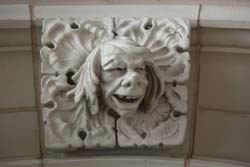




Harris Hall has the greatest variety of gargoyle artistic styles. Above, the faces inside
floral wreaths over the North and South portals bear striking simularity to tiles produced
for buildings in Chicago only a few years earlier. Compare these to numbers 13 (center in
third row), 19-22 (last two of fourth row) and 24-26 (last three of last row), then you
will see that the numerous styles must be attributed to individual artists plying their trade
as much as an architect inspiring design.
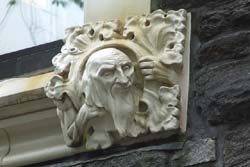



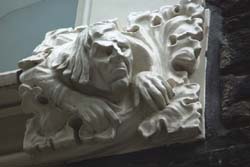
Wingate Hall on the south side of the plaza, has the least creative gargoyle set.
There are four designs as two left and two right window cornice gargoyles that are repeated
as alternating pairs around the building between the first and second floor.
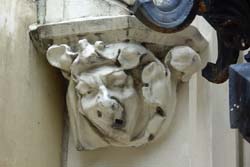




Images 6 and 10, both of the right cornice gargoyles of Wingate Hall, are representive of employing a
mass molded clay base tile of floral leaves with added central face medalion and
additional attached adornment, such as left hand and right arm in the case of image 10.
This tile also shows minor modifications, for example, bending of the base to accomodate
the right arm placement (left side of image).



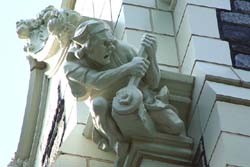

Careful examination and comparison of
duplicate tiles show very minor differences, which are due to craftsman
variation in assembling and joining the leather hard pre-formed clay pieces.
For example, image 5 has an added left hand, image 4 has both arms applied to body,
images 6 - 10 each have clay hair manually applied after each molded head was added to
the base rose, or leaf tile base.
Tile molds were single piece for simple, repetative shapes, but
complex detail as found on gargoyles required multi-part forms with keys
to ensure registration. Complex molds were made in a long, labor intensive
and time consuming multi-step process. First, a temporary, but completely
worked clay sculpture was made on a wooden armature. At this point, some
designs demanded that the figure be cut apart to enable mold creation or
to give suitable sized tiles. Next, a quick multi-part plaster mold was
made from the clay originals. These molds were used to cast final plaster
masters over a ridgid hardwood armature. Each plaster master was filed and
sanded to the final shape, then coated, usually with a water resistant
varnish as a parting compound. The working multipart plaster molds were
then cast, often repeatedly, from the master. Several of these masters,
over a hundred years old, are now on display in Shepard Hall. Each is a
great work of art in its own right by an unnamed artist.
Tiles were hand formed by first slip casting a thin clay
layer and waiting for it to become leather hard, followed by tamping
fist-sized pieces of stiff, plastic-texture clay into the plaster lined
wooden box mold with a blunt wooden tool and a mallet, followed by a third,
thin layer of the same clay as on the mold surface. The completed three
layered clay tile was allowed to partially dry by absorbtion of more water
from the clay into the plaster and stiffen enough for removal. This
layered tile construction has a smooth surface for bonding to the glaze
and a tougher, lower density core. The third layer of clay is necessary
to control curling. Tiles, called greenware at this stage, were removed
from the mold and covered with wet burlap and allowed to dry slowly
indoors to minimize warpage, give even shrinkage and reduce internal stresses.
Yet some shrinkage did occur, especially with gargoyles which were often
made by extensive hand joining of molded parts to base tiles and have
non-uniform thickness.
Greenware tiles were fired to a bisque stage at cone 06 (1830 deg F) after
many weeks of drying. The clay body contained about 50% white ball clay
having a high percentage of talc and fine silica sand, so no consolidation
of the clay body normally occurs. Glaze was applied by dipping into a
slurry of clay (maybe Bentonite), silica sand, feldspar, a whitening agent
and fluxing agents (borax and zinc oxide). An example of substantial
shrinkage is tile 23 located on the south side of Baskerville Hall. Note
the difference in base height to the neighboring plain tile. Also note
the glaze crazing at the bottom of tile 24. It is probable that this
shrinkage is due to over firing, with partial vitrification
of the silica in the clay body. With over-firing, microcracks can form
in the clay body radiating from each silica particle because of the
substantial 5% volume change of the silica passing through a transition
temperature (at 1060 deg F), and results in a finished tile with the
potential of future glaze crazing, shivering and increased brittleness.
The dissimilar level joint between the tiles is filled with lead came
pounded in place to prevent water intrusion.

